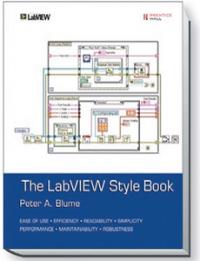
Learn the Industry’s Best-Practices for Developing High-Quality LabVIEW Software
The LabVIEW Style Course is an instructor-led training course in which a Senior Bloomy Engineer presents more than 200 guidelines or “rules” for developing high-quality LabVIEW software conforming to the industry’s best practices. Based on The LabVIEW Style Book (© 2007, Prentice Hall), the style rules are designed to optimize the ease of use, efficiency, readability, simplicity, performance, maintainability, and reliability of your LabVIEW VIs. The LabVIEW Style Course is ideal for the following types of developers and situations:
- Multideveloper organizations that need to understand, utilize, and maintain each other’s code
- Software developed for regulated industries requiring conformance to a documented coding standard
- Individual developers that simply wish to improve their skills
Students are encouraged to bring in their own code base to help them learn and apply the style rules to real projects, and thereby maximize the benefits of the course. The course can be customized based on student objectives and schedule. For best results, lectures are broken up into weekly or two-per-week training modules with reading and programming assignments spanning a 4-6 week period. The course can be taught online using a virtual classroom environment, or in a physical classroom.
Course Outline
Significance of style: How good style improves quality and actually saves time over the full project life cycle
Before you code: Configuring your LabVIEW environment, and organizing your files on disk and in the LabVIEW project
LabVIEW project specifications: A specialized standard for specifying LabVIEW application requirements
Efficient VI layout and development: front panel, block diagram, icons, and connectors
Data structures: Choosing data types, efficient use of arrays and clusters, and special considerations with nested data structures
Error handling: Trapping and reporting errors for robust and reliable applications
Design patterns: Standard VI architectures and application frameworks that promote good style
Documentation: Essential rules for source code documentation and streamlining the process
Code reviews: Enforcing a style convention using a checklist, the LabVIEW VI Analyzer Toolkit, and peer reviews
*Note – you must understand the fundamentals of LabVIEW as a prerequisite for attending this course. NI LabVIEW Core 1 & 2 training or equivalent, and some hands-on development experience are required.
Do you have a demanding project with an aggressive schedule and a technical skills gap with NI software? Consider Bloomy’s Project Launch training, or NI software consulting services.
